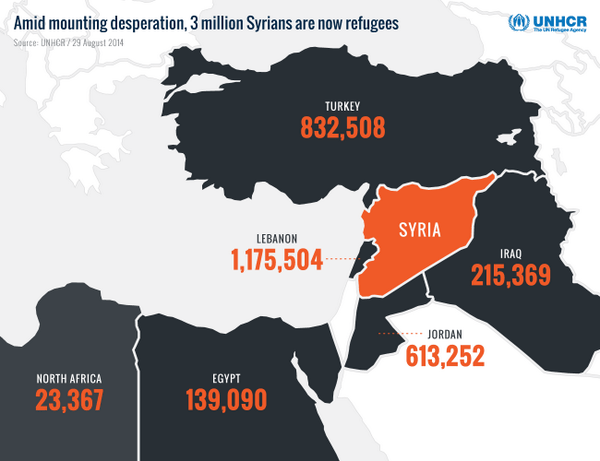As the Syrian conflict enters its fourth winter, the displacement emergency is reaching a fever pitch. The statistics are staggering: there are approximately 3.2 million Syrian refugees in neighboring countries, over 6.5 million internally displaced Syrians (almost 50% more than in 2013), and 10.8 million of Syria’s 22 million population is considered affected by the conflict and in need of humanitarian assistance by the UN Refuge Agency. At least half of the displaced are children.
The agency is expecting these numbers to rise in 2015, with no political solution in sight and military confrontation continuing. This week, the UNHCR held a meeting with 28 countries participating to increase the number of resettlement spots available globally to 100,000. That is a start. But even this increase falls far short of the demand.
Currently, there are over 3 million Syrian refugees in Lebanon, Turkey, Jordan, Iraq and Egypt, and the UN Refugee Agency estimates that approximately 10% – or 320,000 – of these refugees are in situations of extreme vulnerability. This means that their humanitarian needs cannot be met simply through food or other aid available – as meager as it is – locally. The extremely vulnerable refugees are individuals who fall within existing global resettlement guidelines, such as survivors of torture, single mothers, or refugees with serious medical conditions. They deserve resettlement under international protocol.
Simple math shows quite clearly that the 100,000 resettlement spots available through the end of 2016 will only take care of approximately 30% of the total case load of extremely vulnerable refugees – provided that these numbers do not rise, which they are expected to. So far, Germany has so far provided 20,000 spaces for Syrian refugees under the UN program, and Sweden 9,000. The EU-wide commitment for the resettlement of Syrian refugees is 34,000. In contrast, the UK has declined to take part in the resettlement program, and launched their own program this year, which, so far, has provided 90 refugees with resettlement options in the UK. On the other side of the Atlantic, the US and Canada have resettled a little over 5,000 Syrian refugees, and the United States is currently reviewing 9,000 UN Refugee Agency referrals.
Head of UNHCR Antonio Guterres said that the resettlement program was key in helping prevent a lost generation, and a lost future for Syria. He also confirmed that only 66,254 of the 100,000 announced resettlement spots are “firm and concrete”, leaving quite a gap between pledged and actual commitments. The emergency in Syria – which is compounded by the fact that Syria itself hosts hundreds of thousands of refugees, primarily from Iraq, and is the scene of not only an internal conflict but also a key hub for the dangerously destabilizing ISIS group – is far from over, and shows no real sign of abatement.
With neighboring countries bearing the brunt of refugee assistance, and the WFP struggling to provide the needed food assistance due to funding shortfalls and unpredictability, it is essential that the international community pull together to offer the victims of the Syrian conflict the support and aid they deserve, and to open up their borders to individuals and families who need it most. Nothing less than the future of an entire generation, and a nation is at stake. More resettlement places for refugees must be made available, and fast.
